Molecular Framework of Mouse Endothelial Cell Dysfunction during Inflammation: A Proteomics Approach
Abstract
1. Introduction
2. Results
2.1. Global Proteomic Analysis Identifies Differentially Expressed Proteins in ECs in Response to Inflammatory Stimuli
2.2. Functional Enrichment Analysis
2.3. Statistical Analysis
3. Discussion
4. Materials and Methods
4.1. Endothelial Cell Preparation
4.2. Global Label-Free Proteomic Analysis
4.3. Bioinformatic Analysis
4.4. Statistical Analysis
Supplementary Materials
Author Contributions
Funding
Institutional Review Board Statement
Informed Consent Statement
Data Availability Statement
Conflicts of Interest
Abbreviations
| ANOVA | Analysis of Variance |
| Acod1 | Aconitate decarboxylase 1 |
| Arg1 | Arginase 1 |
| BP | Biological process |
| Bcl11b | B cell leukemia/lymphoma 11B |
| Crp | C-reactive protein |
| Ctla2a | Cytotoxic T lymphocyte-associated protein 2 alpha |
| C1qc | Complement component 1, q subcomponent, C chain |
| Clec2d | C-type lectin domain family 2, member d |
| Cebpb | CCAAT/enhancer binding protein (C/EBP), beta |
| Cd44 | Cluster of differentiation 44 |
| Cx3cl1 | Chemokine (C-X3-C motif) ligand 1 |
| Comp | Cartilage oligomeric matrix protein |
| Cd274 | Cluster of differentiation 274 |
| Ccl2 | C-C motif chemokine ligand 2 |
| Cbr4 | Carbonyl reductase 4 |
| DAMPs | Damage-associated molecular patterns |
| DEP | Differentially expressed protein |
| EC | Endothelial cell |
| Ets1 | ETS proto-oncogene 1 |
| Ednrb | Endothelin receptor type b |
| Emc10 | ER membrane protein complex subunit 10 |
| Fam181b | Family with sequence similarity 181, member B |
| Fbln1 | Fibulin 1 |
| Fli1 | Friend Leukemia Integration 1 |
| Foxc2 | Forkhead box c2 |
| GO | Gene ontology |
| Gimap3 | GTPase of immunity associated protein 3 |
| Gimap5 | GTPase of immunity associated protein 5 |
| Gja1 | Gap junction protein, alpha 1 |
| Hk2 | Hexokinase 2 |
| Hpse | Heparinase |
| H2-k1 | Histocompatibility 2, K1, K region |
| Hyal2 | Hyaluronidase 2 |
| Hmgb1 | High mobility group box 1 |
| IL-1β | Interleukin-1 beta |
| IFN-γ | Interferon-gamma |
| Il6 | Interleukin-6 |
| Ifit2 | Interferon-induced protein with tetratricopeptide repeats 2 |
| Ifit1 | Interferon-induced protein with tetratricopeptide repeats 1 |
| Ifi44 | Interferon-induced protein with tetratricopeptide repeats 44 |
| Irak2 | Interleukin 1 receptor associated kinase 2 |
| Irf1 | Interferon regulatory factor 1 |
| Lys-C | Lysyl-endopeptidase |
| MANOVA | Multivariate analysis of variance |
| MS/MS | Tandem mass spectrometry |
| Met | Methionine |
| (m)M | Millimolar |
| Mospd3 | Motile sperm domain containing 3 |
| Mapk | Mitogen-activated protein kinase |
| NF-kβ | Nuclear factor kappa beta |
| Nrp1 | Neuropilin 1 |
| Nsd2 | Nuclear receptor-binding SET domain protein 2 |
| ORA | Overrepresentation analysis |
| Parp14 | Poly(ADP-Ribose) polymerase family member 14 |
| Panx1 | Pannexin 1 |
| Ptprb | Protein tyrosine phosphatase receptor type B |
| Ptgs2 | Prostaglandin-endoperoxide synthase 2 |
| Postn | Periostin |
| Ptpn5 | Protein tyrosine phosphatase, non-receptor type 5 |
| Pdcd4 | Programmed cell death 4 |
| PRIDE | Proteomics identification database |
| Prox1 | Prospero homeobox 1 |
| Rsad2 | Radical S-adenosyl methionine domain containing 2 |
| Rgcc | Regulator of cell cycle |
| Ripk2 | Receptor interacting serine/threonine kinase 2 |
| RSLC | Rapid separation liquid chromatography |
| Selp | P-selectin |
| Sox13 | SRY (sex determining region Y)-box 13 |
| Smim4 | Small integral membrane protein 4 |
| Sp1 | Sp1 transcription factor |
| She | Src homolog 2 domain containing E |
| TNF-α | Tumor necrosis factor-alpha |
| Timm17a | Translocase of inner mitochondrial membrane 17a |
| Tlr4 | Toll-like receptor 4 |
| Trex1 | Three prime repair exonuclease 1 |
| Tap1 | Transporter 1, ATP binding cassette subfamily B member |
| Tlr9 | Toll-like receptor 9 |
| Tie1 | Tyrosine kinase with immunoglobulin-like and egf-like domains 1 |
| Tnfaip2 | Tumor necrosis factor alpha-induced protein 2 |
| Vcam-1 | Vascular cell adhesion molecule 1 |
| Vwf | von Willebrand factor |
References
- Yang, Q.; Wijerathne, H.; Langston, J.; Kiani, M.; Kilpatrick, L. Emerging Approaches to Understanding Microvascular Endothelial Heterogeneity: A Roadmap for Developing Anti-Inflammatory Therapeutics. Int. J. Mol. Sci. 2021, 22, 7770. [Google Scholar] [CrossRef] [PubMed]
- Wijerathne, H.; Langston, J.C.; Yang, Q.; Sun, S.; Miyamoto, C.; Kilpatrick, L.E.; Kiani, M.F. Mechanisms of radiation-induced endothelium damage: Emerging models and technologies. Radiother. Oncol. 2021, 158, 21–32. [Google Scholar] [CrossRef]
- Maniatis, N.A.; Orfanos, S.E. The endothelium in acute lung injury/acute respiratory distress syndrome. Curr. Opin. Crit. Care 2008, 14, 22–30. [Google Scholar] [CrossRef] [PubMed]
- Nourshargh, S.; Alon, R. Leukocyte migration into inflamed tissues. Immunity 2014, 41, 694–707. [Google Scholar] [CrossRef] [PubMed]
- Kiseleva, R.; Glassman, P.; Greineder, C.; Hood, E.; Shuvaev, V.; Muzykantov, V. Targeting therapeutics to endothelium: Are we there yet? Drug Deliv. Transl. Res. 2018, 8, 883–902. [Google Scholar] [CrossRef] [PubMed]
- Augustin, H.G.; Koh, G.Y. Organotypic vasculature: From descriptive heterogeneity to functional pathophysiology. Science 2017, 357, eaal2379. [Google Scholar] [CrossRef] [PubMed]
- Aird, W.C. Endothelial Cell Heterogeneity. Cold Spring Harb. Perspect. Med. 2012, 2, a006429. [Google Scholar] [CrossRef] [PubMed]
- Marcu, R.; Choi, Y.J.; Xue, J.; Fortin, C.L.; Wang, Y.; Nagao, R.J.; Xu, J.; MacDonald, J.W.; Bammler, T.K.; Murry, C.E.; et al. Human Organ-Specific Endothelial Cell Heterogeneity. iScience 2018, 4, 20–35. [Google Scholar] [CrossRef]
- Rhee, C.; Dantes, R.; Epstein, L.; Murphy, D.J.; Seymour, C.W.; Iwashyna, T.J.; Kadri, S.S.; Angus, D.C.; Danner, R.L.; Fiore, A.E.; et al. Incidence and Trends of Sepsis in US Hospitals Using Clinical vs Claims Data, 2009–2014. J. Am. Med. Assoc. 2017, 318, 1241–1249. [Google Scholar] [CrossRef]
- Angus, D.C.; Linde-Zwirble, W.T.; Lidicker, J.; Clermont, G.; Carcillo, J.; Pinsky, M.R. Epidemiology of severe sepsis in the United States: Analysis of incidence, outcome, and associated costs of care. Crit. Care Med. 2001, 29, 1303–1310. [Google Scholar] [CrossRef]
- Iskander, K.N.; Osuchowski, M.F.; Stearns-Kurosawa, D.J.; Kurosawa, S.; Stepien, D.; Valentine, C.; Remick, D.G. Sepsis: Multiple Abnormalities, Heterogeneous Responses, and Evolving Understanding. Physiol. Rev. 2013, 93, 1247–1288. [Google Scholar] [CrossRef]
- Hattori, Y.; Hattori, K.; Suzuki, T.; Matsuda, N. Recent advances in the pathophysiology and molecular basis of sepsis-associated organ dysfunction: Novel therapeutic implications and challenges. Pharmacol. Ther. 2017, 177, 56–66. [Google Scholar] [CrossRef]
- Raju, S.M.; Jahnavi, V.; Kamaraju, R.S.; Sritharan, V.; Rajkumar, K.; Natarajan, S.; Kumar, A.D.; Burgula, S. Continuous evaluation of changes in the serum proteome from early to late stages of sepsis caused by Klebsiella pneumoniae. Mol. Med. Rep. 2016, 13, 4835–4844. [Google Scholar] [CrossRef]
- Hasin, Y.; Seldin, M.; Lusis, A. Multi-omics approaches to disease. Genome Biol. 2017, 18, 83. [Google Scholar] [CrossRef]
- Langston, J.C.; Rossi, M.T.; Yang, Q.; Ohley, W.; Perez, E.; Kilpatrick, L.E.; Prabhakarpandian, B.; Kiani, M.F. Omics of Endothelial Cell Dysfunction in Sepsis. Vasc. Biol. 2022, 4, R15–R34. [Google Scholar] [CrossRef]
- Pimienta, G.; Heithoff, D.M.; Rosa-Campos, A.; Tran, M.; Esko, J.D.; Mahan, M.J.; Marth, J.D.; Smith, J.W. Plasma Proteome Signature of Sepsis: A Functionally Connected Protein Network. Proteomics 2019, 19, e1800389. [Google Scholar] [CrossRef]
- Toledo, A.G.; Golden, G.; Campos, A.R.; Cuello, H.; Sorrentino, J.; Lewis, N.; Varki, N.; Nizet, V.; Smith, J.W.; Esko, J.D. Proteomic atlas of organ vasculopathies triggered by Staphylococcus aureus sepsis. Nat. Commun. 2019, 10, 13. [Google Scholar] [CrossRef]
- Luo, T.; Yan, H.P.; Li, X.; Deng, Y.C.; Huang, J.T.; Li, L.P.; Xiao, Z.H.; Lu, X.L. Proteomic analysis identified potential age-associated prognostic biomarkers in pneumonia-derived paediatric sepsis. Proteom. Clin. Appl. 2021, 16, 2100036. [Google Scholar] [CrossRef]
- Jiao, J.; Gao, M.; Zhang, H.L.; Wang, N.; Xiao, Z.H.; Liu, K.; Yang, M.S.; Wang, K.K.; Xiao, X.Z. Identification of potential biomarkers by serum proteomics analysis in rats with sepsis. Shock 2014, 42, 75–81. [Google Scholar] [CrossRef]
- Scicluna, B.P.; van Vught, L.A.; Zwinderman, A.H.; Wiewel, M.A.; Davenport, E.E.; Burnham, K.L.; Nurnberg, P.; Schultz, M.J.; Horn, J.; Cremer, O.L.; et al. Classification of patients with sepsis according to blood genomic endotype: A prospective cohort study. Lancet Respir. Med. 2017, 5, 816–826. [Google Scholar] [CrossRef]
- Davenport, E.E.; Burnham, K.L.; Radhakrishnan, J.; Humburg, P.; Hutton, P.; Mills, T.C.; Rautanen, A.; Gordon, A.C.; Garrard, C.; Hill, A.V.S.; et al. Genomic landscape of the individual host response and outcomes in sepsis: A prospective cohort study. Lancet Respir. Med. 2016, 4, 259–271. [Google Scholar] [CrossRef]
- Wong, H.R.; Cvijanovich, N.; Lin, R.; Allen, G.L.; Thomas, N.J.; Willson, D.F.; Freishtat, R.J.; Anas, N.; Meyer, K.; Checchia, P.A.; et al. Identification of pediatric septic shock subclasses based on genome-wide expression profiling. BMC Med. 2009, 7, 34. [Google Scholar] [CrossRef] [PubMed]
- Wang, L.F.; Chung, J.; Gill, S.E.; Mehta, S. Quantification of adherens junction disruption and contiguous paracellular protein leak in human lung endothelial cells under septic conditions. Microcirculation 2019, 26, e12528. [Google Scholar] [CrossRef] [PubMed]
- Wong, E.; Nguyen, N.; Hellman, J. Isolation of Primary Mouse Lung Endothelial Cells. J. Vis. Exp. 2021, 177, e63253. [Google Scholar] [CrossRef]
- Liu, S.G.; Stolz, D.B.; Sappington, P.L.; Macias, C.A.; Killeen, M.E.; Tenhunen, J.J.; Delude, R.L.; Fink, M.P. HMGB1 is secreted by immunostimulated enterocytes and contributes to cytomix-induced hyperpermeability of Caco-2 monolayers. Am. J. Physiol. Cell Physiol. 2006, 290, C990–C999. [Google Scholar] [CrossRef]
- Julian, M.W.; Bao, S.Y.; Knoell, D.L.; Fahy, R.J.; Shao, G.H.; Crouser, E.D. Intestinal epithelium is more susceptible to cytopathic injury and altered permeability than the lung epithelium in the context of acute sepsis. Int. J. Exp. Pathol. 2011, 92, 366–376. [Google Scholar] [CrossRef]
- Ashburner, M.; Ball, C.A.; Blake, J.A.; Botstein, D.; Butler, H.; Cherry, J.M.; Davis, A.P.; Dolinski, K.; Dwight, S.S.; Eppig, J.T.; et al. Gene Ontology: Tool for the unification of biology. Nat. Genet. 2000, 25, 25–29. [Google Scholar] [CrossRef]
- Jiang, Y.; Jia, Y.F.; Zhang, L.N. Role of programmed cell death 4 in diseases: A double-edged sword. Cell. Mol. Immunol. 2017, 14, 884–886. [Google Scholar] [CrossRef][Green Version]
- Kilpatrick, L.E.; Kiani, M.F. Experimental Approaches to Evaluate Leukocyte-Endothelial Cell Interactions in Sepsis and Inflammation. Shock 2020, 53, 585–595. [Google Scholar] [CrossRef]
- McEver, R.P. Selectins: Initiators of leucocyte adhesion and signalling at the vascular wall. Cardiovasc. Res. 2015, 107, 331–339. [Google Scholar] [CrossRef]
- Wu, R.L.; Chen, F.; Wang, N.; Tang, D.L.; Kang, R. ACOD1 in immunometabolism and disease. Cell. Mol. Immunol. 2020, 17, 822–833. [Google Scholar] [CrossRef]
- Jiao, H.P.; Wachsmuth, L.; Kumari, S.; Schwarzer, R.; Lin, J.; Eren, R.O.; Fisher, A.; Lane, R.; Young, G.R.; Kassiotis, G.; et al. Z-nucleic-acid sensing triggers ZBP1-dependent necroptosis and inflammation. Nature 2020, 580, 391–395. [Google Scholar] [CrossRef]
- Xu, C.; Xu, J.B.; Lu, L.; Tian, W.D.; Ma, J.L.; Wu, M. Identification of key genes and novel immune infiltration-associated biomarkers of sepsis. Innate Immun. 2020, 26, 666–682. [Google Scholar] [CrossRef]
- Reyes, M.; Filbin, M.R.; Bhattacharyya, R.P.; Sonny, A.; Mehta, A.; Billman, K.; Kays, K.R.; Pinilla-Vera, M.; Benson, M.E.; Cosimi, L.A.; et al. Plasma from patients with bacterial sepsis or severe COVID-19 induces suppressive myeloid cell production from hematopoietic progenitors in vitro. Sci. Transl. Med. 2021, 13, eabe9599. [Google Scholar] [CrossRef]
- Drakeford, C.; O’Donnell, J.S. Targeting von Willebrand Factor-Mediated Inflammation. Arterioscler. Thromb. Vasc. Biol. 2017, 37, 1590–1591. [Google Scholar] [CrossRef]
- Simmons, J.; Pittet, J.F. The coagulopathy of acute sepsis. Curr. Opin. Anesthesiol. 2015, 28, 227–236. [Google Scholar] [CrossRef]
- Caraballo, C.; Jaimes, F. Organ Dysfunction in Sepsis: An Ominous Trajectory From Infection To Death. Yale J. Biol. Med. 2019, 92, 629–640. [Google Scholar]
- Wang, L.; Mehta, S.; Brock, M.; Gill, S.E. Inhibition of Murine Pulmonary Microvascular Endothelial Cell Apoptosis Promotes Recovery of Barrier Function under Septic Conditions. Mediat. Inflamm. 2017, 2017, 3415380. [Google Scholar] [CrossRef]
- Dolmatova, E.V.; Wang, K.K.; Mandavilli, R.; Griendling, K.K. The effects of sepsis on endothelium and clinical implications. Cardiovasc. Res. 2021, 117, 60–73. [Google Scholar] [CrossRef]
- Joffre, J.; Hellman, J.; Ince, C.; Ait-Oufella, H. Endothelial Responses in Sepsis. Am. J. Respir. Crit. Care Med. 2020, 202, 361–370. [Google Scholar] [CrossRef]
- Nedeva, C.; Menassa, J.; Puthalakath, H. Sepsis: Inflammation Is a Necessary Evil. Front. Cell Dev. Biol. 2019, 7, 108. [Google Scholar] [CrossRef]
- Seymour, C.W.; Kennedy, J.N.; Wang, S.; Chang, C.C.H.; Elliott, C.F.; Xu, Z.Y.; Berry, S.; Clermont, G.; Cooper, G.; Gomez, H.; et al. Derivation, Validation, and Potential Treatment Implications of Novel Clinical Phenotypes for Sepsis. J. Am. Med. Assoc. 2019, 321, 2003–2017. [Google Scholar] [CrossRef]
- Jeong, J.H.; Ojha, U.; Lee, Y.M. Pathological angiogenesis and inflammation in tissues. Arch. Pharmacal Res. 2021, 44, 1–15. [Google Scholar] [CrossRef]
- Lupu, F.; Kinasewitz, G.; Dormer, K. The role of endothelial shear stress on haemodynamics, inflammation, coagulation and glycocalyx during sepsis. J. Cell. Mol. Med. 2020, 24, 12258–12271. [Google Scholar] [CrossRef]
- Malekmohammad, K.; Bezsonov, E.E.; Rafieian-Kopaei, M. Role of Lipid Accumulation and Inflammation in Atherosclerosis: Focus on Molecular and Cellular Mechanisms. Front. Cardiovasc. Med. 2021, 8, 707529. [Google Scholar] [CrossRef] [PubMed]
- Nitz, K.; Lacy, M.; Atzler, D. Amino Acids and Their Metabolism in Atherosclerosis. Arterioscler. Thromb. Vasc. Biol. 2019, 39, 319–330. [Google Scholar] [CrossRef]
- Wang, X.J.; Luo, D.; Wu, S.S. Molecular Dysfunctions of Mitochondria-Associated Endoplasmic Reticulum Contacts in Atherosclerosis. Oxidative Med. Cell. Longev. 2021, 2021, 2424509. [Google Scholar] [CrossRef]
- Xu, J.; Kitada, M.; Ogura, Y.; Koya, D. Relationship Between Autophagy and Metabolic Syndrome Characteristics in the Pathogenesis of Atherosclerosis. Front. Cell Dev. Biol. 2021, 9, 858. [Google Scholar] [CrossRef]
- Itagaki, K.; Rica, I.; Konecna, B.; Kim, H.I.; Park, J.; Kaczmarek, E.; Hauser, C.J. Role of Mitochondria-Derived Danger Signals Released After Injury in Systemic Inflammation and Sepsis. Antioxid. Redox Signal. 2021, 35, 1273–1290. [Google Scholar] [CrossRef]
- Zhunina, O.A.; Yabbarov, N.G.; Grechko, A.V.; Starodubova, A.V.; Ivanova, E.; Nikiforov, N.G.; Orekhov, A.N. The Role of Mitochondrial Dysfunction in Vascular Disease, Tumorigenesis, and Diabetes. Front. Mol. Biosci. 2021, 8, 671908. [Google Scholar] [CrossRef]
- Hotchkiss, R.S.; Moldawer, L.L.; Opal, S.M.; Reinhart, K.; Turnbull, I.R.; Vincent, J.L. Sepsis and septic shock. Nat. Rev. Dis. Primers 2016, 2, 21. [Google Scholar] [CrossRef] [PubMed]
- Wang, L.F.; Taneja, R.; Wang, W.; Yao, L.J.; Veldhuizen, R.A.W.; Gill, S.E.; Fortin, D.; Inculet, R.; Malthaner, R.; Mehta, S. Human Alveolar Epithelial Cells Attenuate Pulmonary Microvascular Endothelial Cell Permeability under Septic Conditions. PLoS ONE 2013, 8, e55311. [Google Scholar] [CrossRef] [PubMed]
- Molina-Franky, J.; Plaza, D.F.; Merali, C.; Merali, S.; Barrero, C.; Arevalo-Pinzon, G.; Patarroyo, M.E.; Patarroyo, M.A. A novel platform for peptide-mediated affinity capture and LC-MS/MS identification of host receptors involved in Plasmodium invasion. J. Proteom. 2021, 231, 104002. [Google Scholar] [CrossRef] [PubMed]
- Kulak, N.A.; Pichler, G.; Paron, I.; Nagaraj, N.; Mann, M. Minimal, encapsulated proteomic-sample processing applied to copy-number estimation in eukaryotic cells. Nat. Methods 2014, 11, 319–324. [Google Scholar] [CrossRef] [PubMed]
- Scheltema, R.A.; Hauschild, J.P.; Lange, O.; Hornburg, D.; Denisov, E.; Damoc, E.; Kuehn, A.; Makarov, A.; Mann, M. The Q Exactive HF, a Benchtop Mass Spectrometer with a Pre-filter, High-performance Quadrupole and an Ultra-high-field Orbitrap Analyzer. Mol. Cell. Proteom. 2014, 13, 3698–3708. [Google Scholar] [CrossRef]
- Quinn, C.; Rico, M.C.; Merali, C.; Merali, S. Dysregulation of S-adenosylmethionine Metabolism in Nonalcoholic Steatohepatitis Leads to Polyamine Flux and Oxidative Stress. Int. J. Mol. Sci. 2022, 23, 1968. [Google Scholar] [CrossRef]
- Perez-Riverol, Y.; Bai, J.W.; Bandla, C.; Garcia-Seisdedos, D.; Hewapathirana, S.; Kamatchinathan, S.; Kundu, D.J.; Prakash, A.; Frericks-Zipper, A.; Eisenacher, M.; et al. The PRIDE database resources in 2022: A hub for mass spectrometry-based proteomics evidences. Nucleic Acids Res. 2022, 50, D543–D552. [Google Scholar] [CrossRef]
- Deutsch, E.W.; Bandeira, N.; Sharma, V.; Perez-Riverol, Y.; Carver, J.J.; Kundu, D.J.; Garcia-Seisdedos, D.; Jarnuczak, A.F.; Hewapathirana, S.; Pullman, B.S.; et al. The ProteomeXchange consortium in 2020: Enabling “big data” approaches in proteomics. Nucleic Acids Res. 2020, 48, D1145–D1152. [Google Scholar] [CrossRef]
- Lee, M.H. Data analysis with RStudio: An easygoing introduction. Biometrics 2021, 77, 1502–1503. [Google Scholar] [CrossRef]
- Morgan, M. BiocManager: Access the Bioconductor Project Package Repository. Available online: https://CRAN.R-project.org/package=BiocManager (accessed on 10 July 2022).
- Gentleman, R.; Carey, V.; Bates, D.; Bolstad, B.; Dettling, M.; Dudoit, S.; Ellis, B.; Gautier, L.; Ge, Y.; Gentry, J.; et al. Bioconductor: Open software development for computational biology and bioinformatics. Genome Biol. 2004, 5, R80. [Google Scholar] [CrossRef]
- Chen, H. VennDiagram: Generate High-Resolution Venn and Euler Plots. Available online: Ttps://CRAN.R-project.org/package=VennDiagram (accessed on 10 July 2022).
- Carbon, S.; Douglass, E.; Dunn, N.; Good, B.; Harris, N.L.; Lewis, S.E.; Mungall, C.J.; Basu, S.; Chisholm, R.L.; Dodson, R.J.; et al. The Gene Ontology Resource: 20 years and still Going strong. Nucleic Acids Res. 2019, 47, D330–D338. [Google Scholar] [CrossRef]
- Wu, T.; Hu, E.; Xu, S.; Chen, M.; Guo, P.; Dai, Z.; Feng, T.; Zhou, L.; Tang, W.; Zhan, L.; et al. clusterProfiler 4.0: A universal enrichment tool for interpreting omics data. Innovation 2021, 2, 100141. [Google Scholar] [CrossRef]
- Boyle, E.; Weng, S.; Gollub, J.; Jin, H.; Botstein, D.; Cherry, J.; Sherlock, G. GO::TermFinder—Open source software for accessing Gene Ontology information and finding significantly enriched Gene Ontology terms associated with a list of genes. Bioinformatics 2004, 20, 3710–3715. [Google Scholar] [CrossRef]
- Yu, G.C.; Wang, L.G.; Han, Y.Y.; He, Q.Y. ClusterProfiler: An R Package for Comparing Biological Themes Among Gene Clusters. Omics A J. Integr. Biol. 2012, 16, 284–287. [Google Scholar] [CrossRef]
- Zhang, X.F.; Smits, A.H.; van Tilburg, G.B.A.; Ovaa, H.; Huber, W.; Vermeulen, M. Proteome-wide identification of ubiquitin interactions using UbIA-MS. Nat. Protoc. 2018, 13, 530–550. [Google Scholar] [CrossRef]
- Lin, T. Proteomics Data Analysis (2/3): Data Filtering and Missing Value Imputation. Available online: https://datascienceplus.com/proteomics-data-analysis-2-3-data-filtering-and-missing-value-imputation/ (accessed on 13 April 2022).



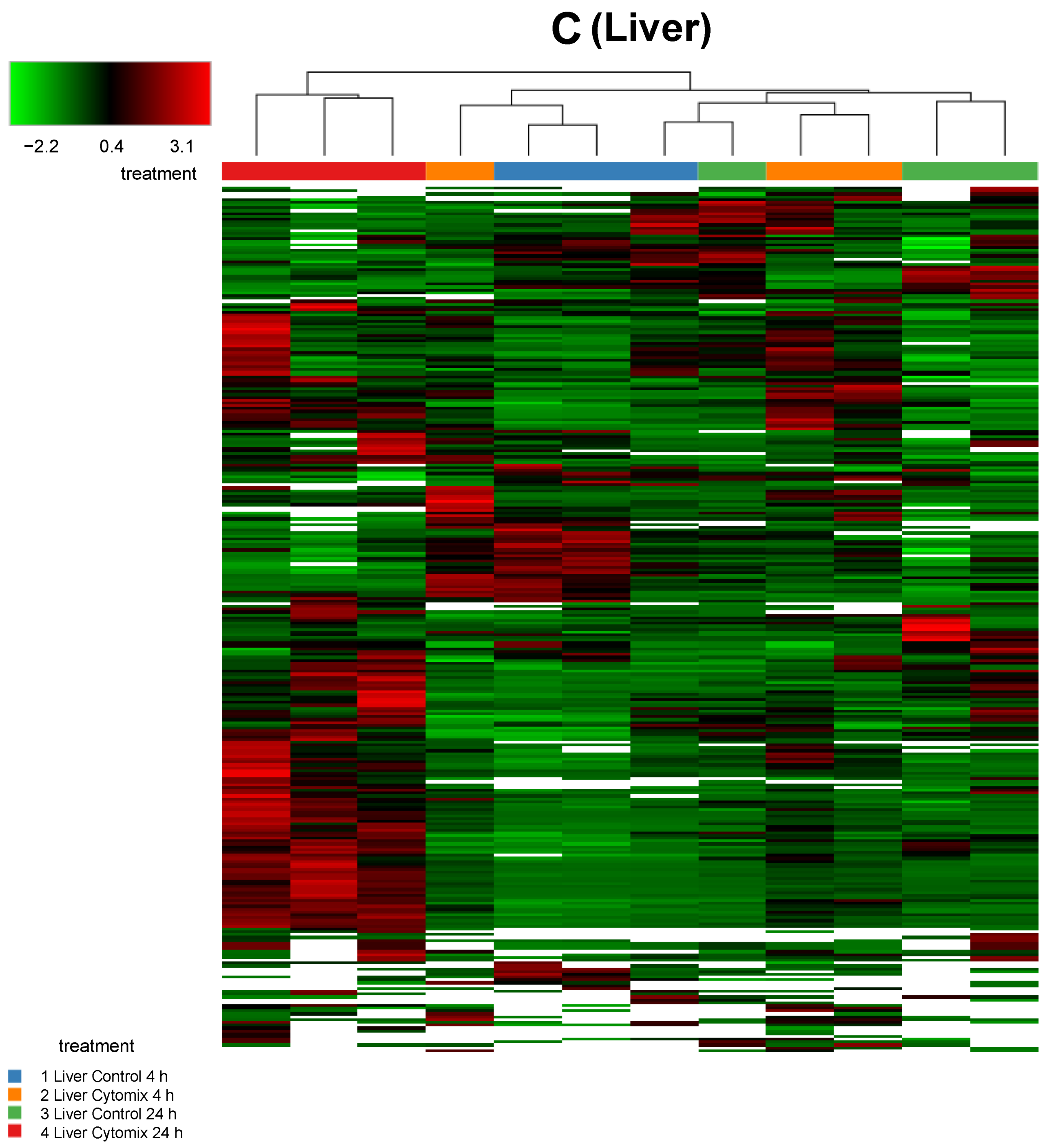
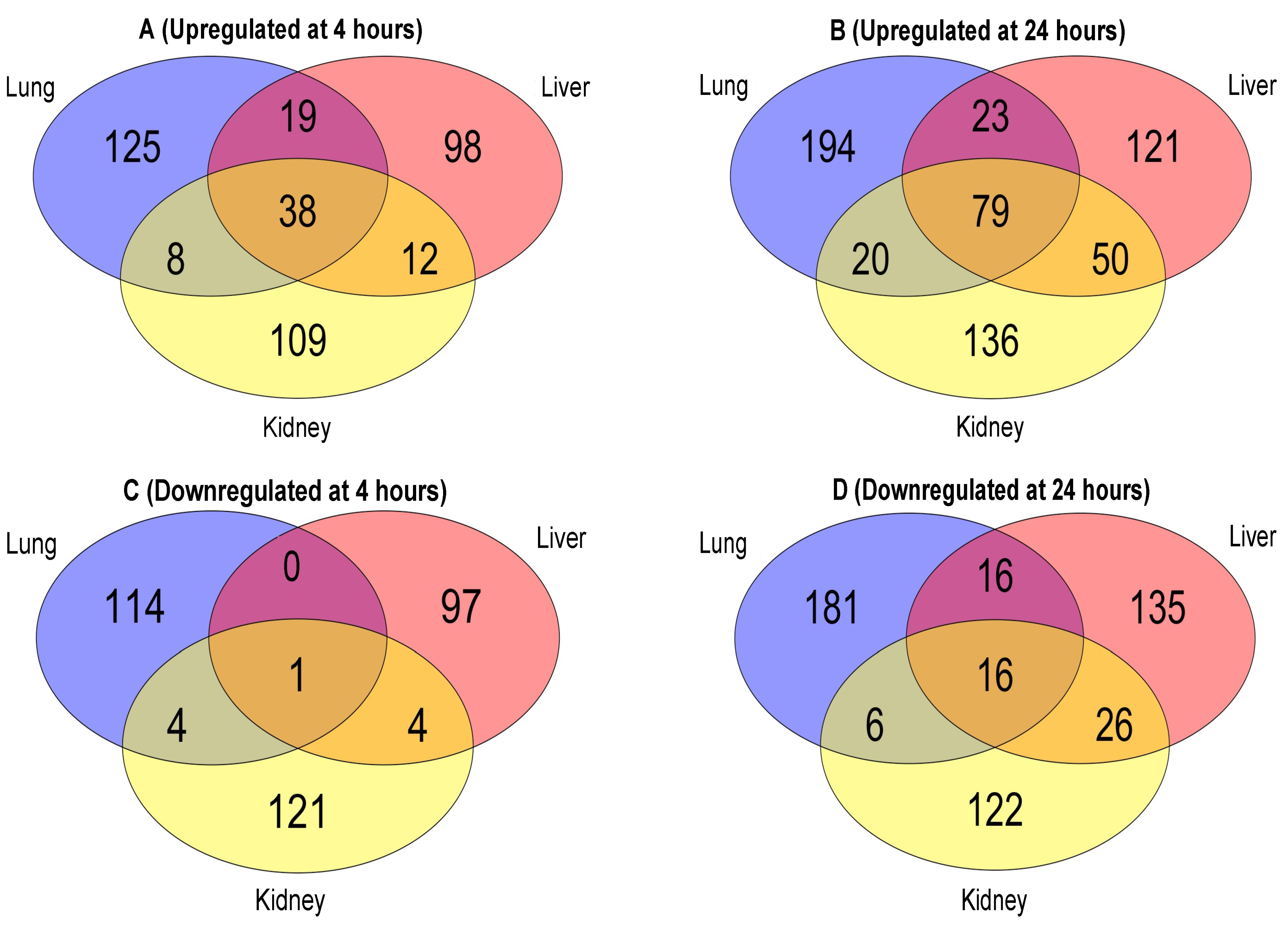
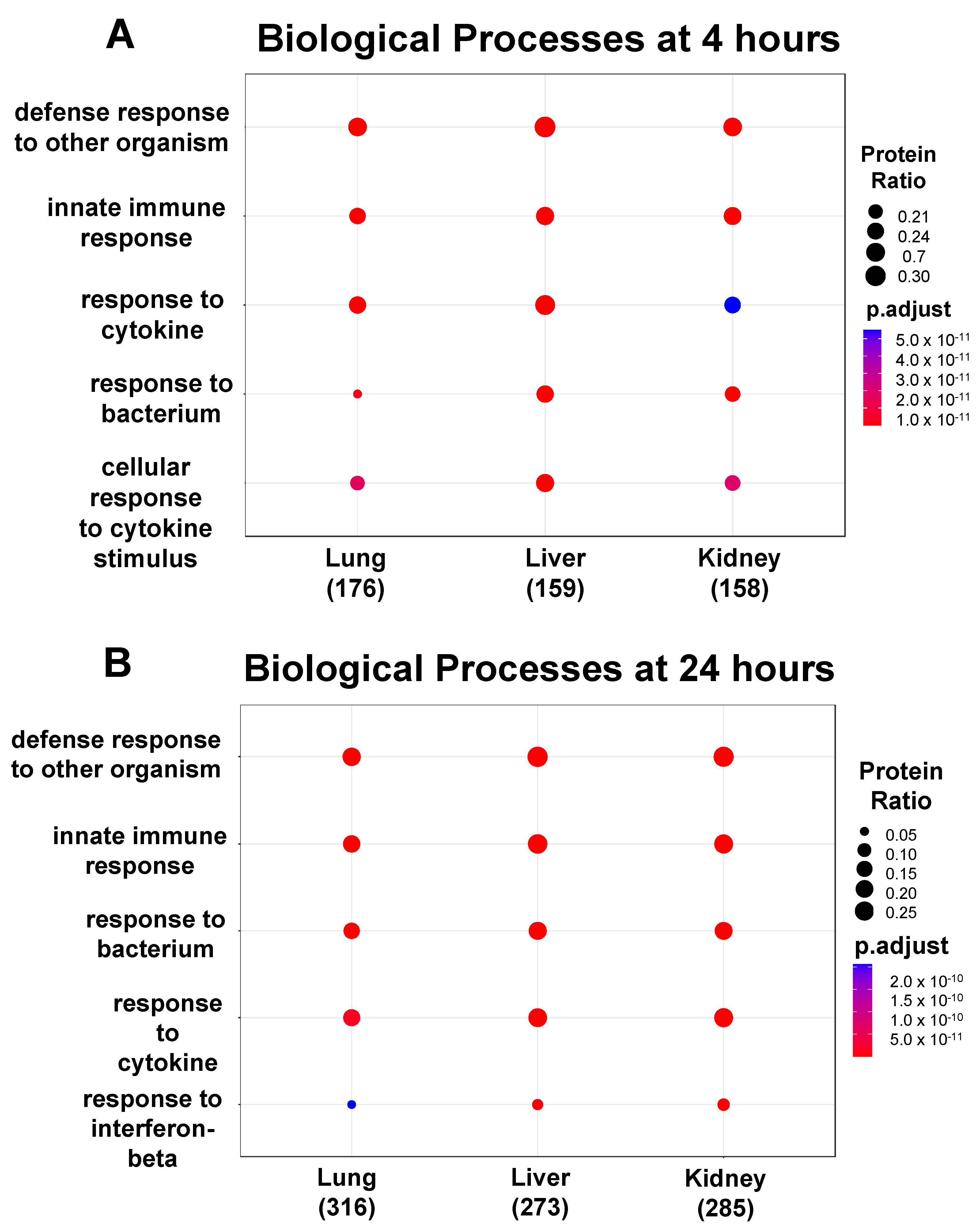

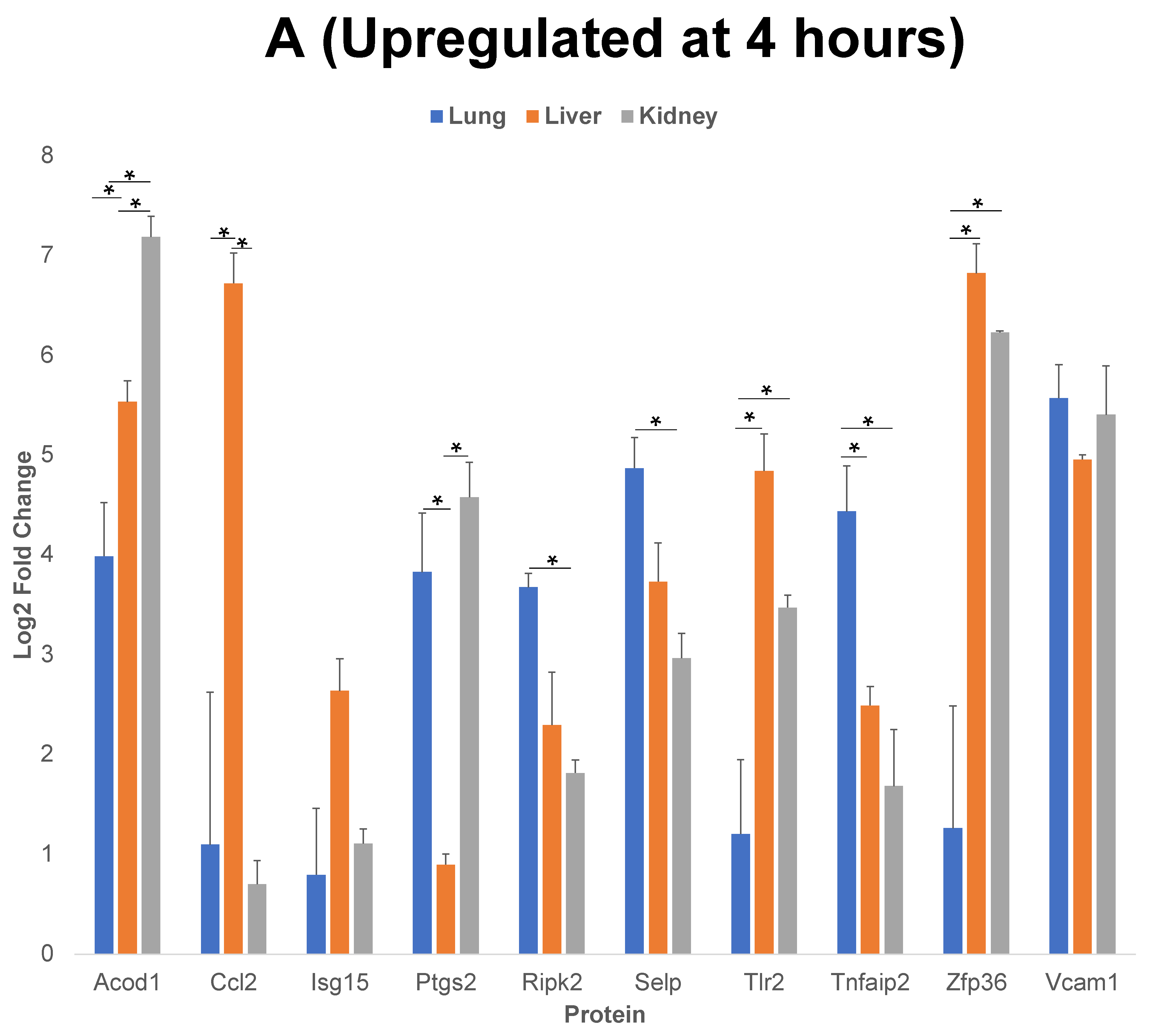
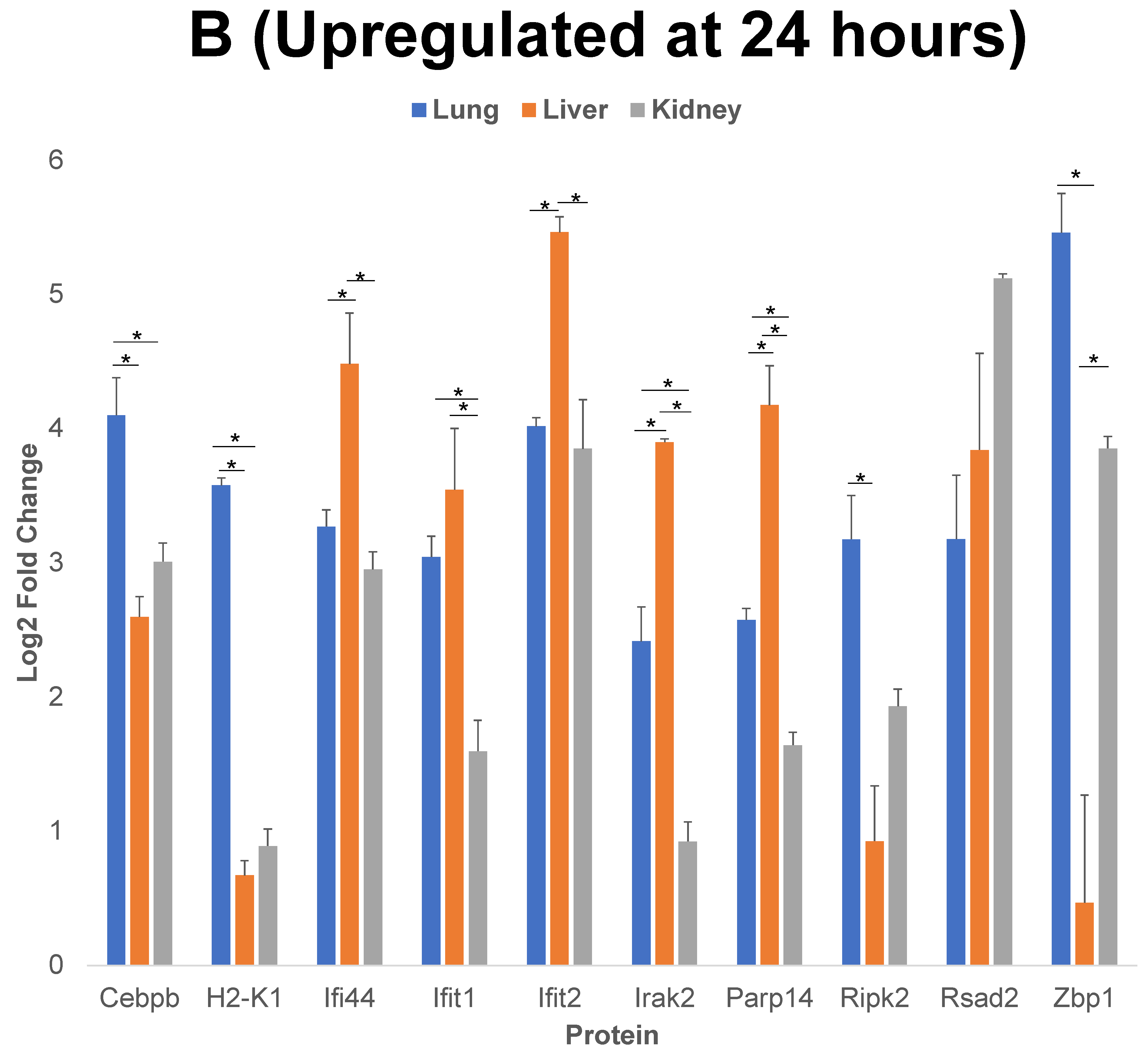
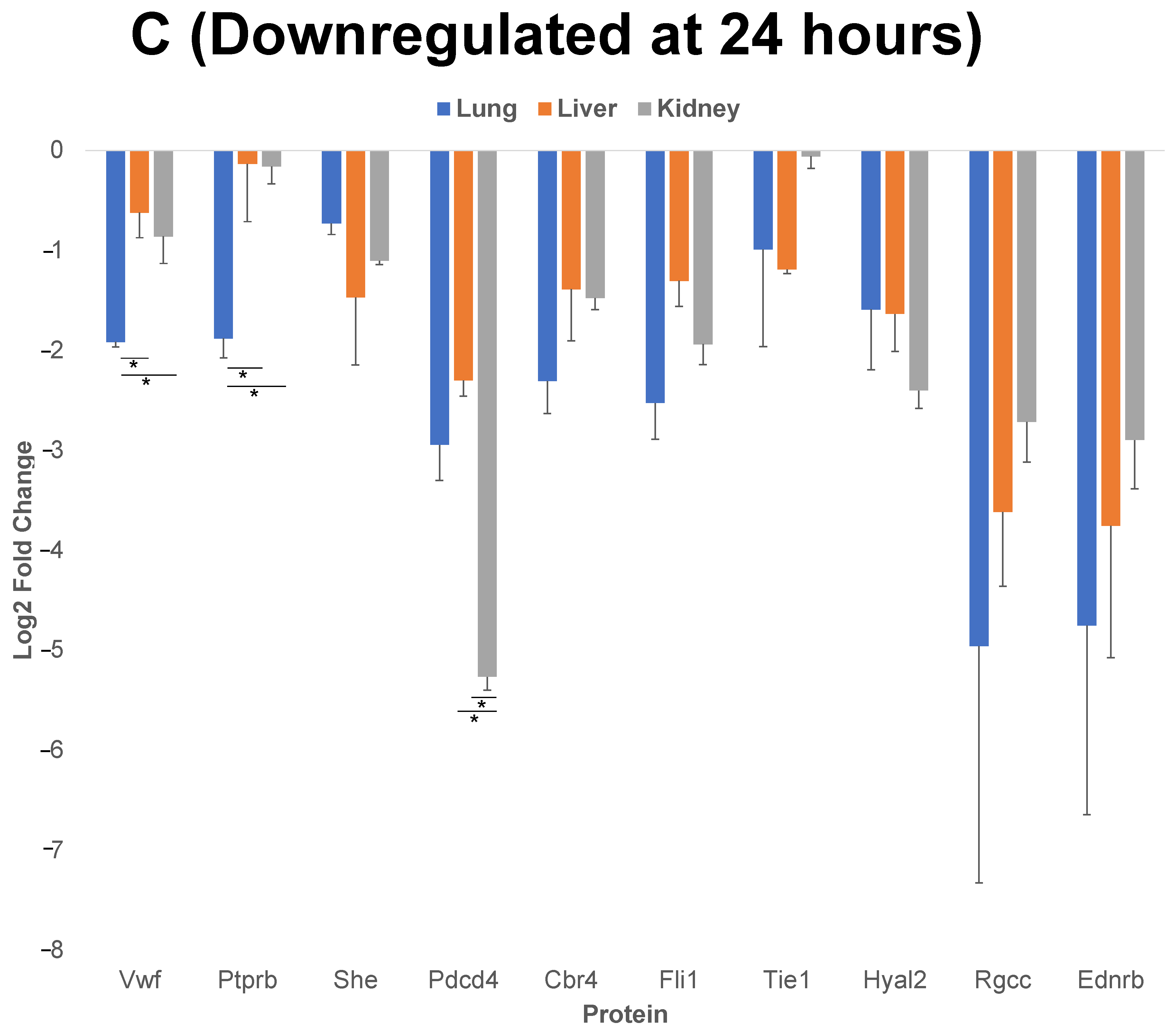

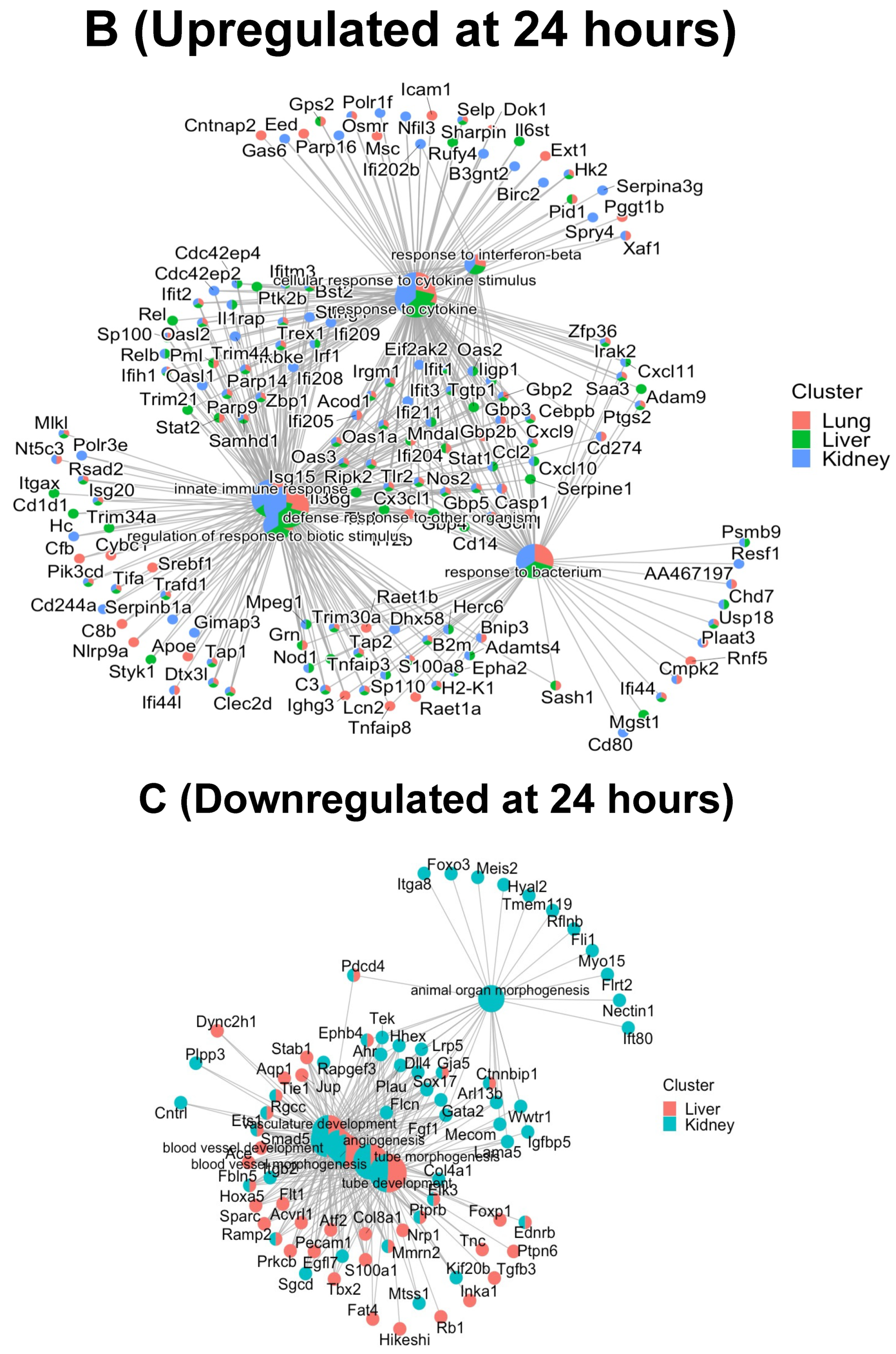
| Protein Class | Protein(s) |
|---|---|
| RNA Metabolism | Zfp36 |
| Cell Adhesion | Vcam-1, Selp |
| Defense/Immunity | Selp, Ccl2, Isg15, Tlr2, Acod1 |
| Intercellular Signaling | Ccl2 |
| Membrane Traffic | Tnfaip2 |
| Metabolite Interconversion Enzyme | Ptgs2, Acod1 |
| Protein Modifying Enzyme | Ripk2 |
| Transmembrane Signal Receptor | Tlr2 |
| Cell-cell signaling | Isg15 |
| Protein Class | Protein(s) |
|---|---|
| DNA Metabolism | Zbp1 |
| Defense/Immunity | Ifit2, Ifit1, H2-k1, Ifi44, Rsad2, Zbp1, Cebpb |
| Gene Specific Transcriptional Regulator | Cebpb |
| Protein Modifying Enzyme | Irak2, Ripk2 |
| Anti-apoptosis | Parp14 |
| Protein Class | Protein(s) |
|---|---|
| Cytoskeletal: Non-Motor Actin Binding | Fli1 |
| Extracellular Matrix | Vwf, Hyal2 |
| Coagulation | Vwf |
| Translation Inhibitor (apoptosis) | Pdcd4 |
| Cell Cycle | Ptprb, Rgcc |
| Protein Binding Activity | She, Cbr4, Ednrb |
| Angiogenesis | Tie1 |
| Cell Proliferation | Hyal2 |
| Metabolite Interconversion Enzyme | Cbr4 |
| Calcium Binding | Ednrb |
Publisher’s Note: MDPI stays neutral with regard to jurisdictional claims in published maps and institutional affiliations. |
© 2022 by the authors. Licensee MDPI, Basel, Switzerland. This article is an open access article distributed under the terms and conditions of the Creative Commons Attribution (CC BY) license (https://creativecommons.org/licenses/by/4.0/).
Share and Cite
Rossi, M.T.; Langston, J.C.; Singh, N.; Merali, C.; Yang, Q.; Merali, S.; Prabhakarpandian, B.; Kilpatrick, L.E.; Kiani, M.F. Molecular Framework of Mouse Endothelial Cell Dysfunction during Inflammation: A Proteomics Approach. Int. J. Mol. Sci. 2022, 23, 8399. https://doi.org/10.3390/ijms23158399
Rossi MT, Langston JC, Singh N, Merali C, Yang Q, Merali S, Prabhakarpandian B, Kilpatrick LE, Kiani MF. Molecular Framework of Mouse Endothelial Cell Dysfunction during Inflammation: A Proteomics Approach. International Journal of Molecular Sciences. 2022; 23(15):8399. https://doi.org/10.3390/ijms23158399
Chicago/Turabian StyleRossi, Michael T., Jordan C. Langston, Narender Singh, Carmen Merali, Qingliang Yang, Salim Merali, Balabhaskar Prabhakarpandian, Laurie E. Kilpatrick, and Mohammad F. Kiani. 2022. "Molecular Framework of Mouse Endothelial Cell Dysfunction during Inflammation: A Proteomics Approach" International Journal of Molecular Sciences 23, no. 15: 8399. https://doi.org/10.3390/ijms23158399
APA StyleRossi, M. T., Langston, J. C., Singh, N., Merali, C., Yang, Q., Merali, S., Prabhakarpandian, B., Kilpatrick, L. E., & Kiani, M. F. (2022). Molecular Framework of Mouse Endothelial Cell Dysfunction during Inflammation: A Proteomics Approach. International Journal of Molecular Sciences, 23(15), 8399. https://doi.org/10.3390/ijms23158399






